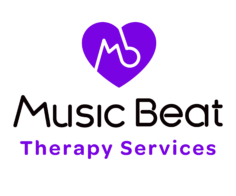What exactly does an “Assistive Solutions Team Leader” do?
Music Beat Therapy Service’s brand-new Assistive Solutions Team Leader, Tom Hockey, answers some of the most commonly asked questions of what exactly this new role involves, and what it means for our clients.
Making music more accessible for everyone
To use a lot of jargon, the Assistive Solutions Team Leader is responsible for researching, acquiring, and developing accessible resources to provide people of all capacities with greater opportunities to engage in meaningful music-making.
To use a bit less jargon, my role is to find ways to make music more accessible for everyone.
This includes, but is not limited to, physical accessibility.
An instrument such as the guitar, for example, requires quite a bit of hand strength and coordination to play in the ‘traditional’ way.
Let’s break it down – in order to play a single note on the guitar:
- You need to be able to support the weight of the guitar on your lap, or with a strap over your shoulder.
- You need to be able to grip and squeeze the neck of the guitar, whilst pushing and holding down a steel or nylon string with your finger.
- You need to make sure you’re pushing hard enough, otherwise the note won’t sound.
- You need to be able to maintain that pressure, otherwise the note will cut out.
- While doing this you need to pluck the string with your other hand.
And if you want to play a chord, you need to be able to do all of the above using up to four fingers at the same time.
A 'non-traditional' approach to making music
For many people, playing the guitar in the ‘traditional’ way is a difficult but achievable task, with time and practice.
For others, whose fine motor strength, coordination and dexterity may be affected by illness, injury or disability, learning to play the guitar in the ‘traditional’ sense may not be feasible.
Fortunately, there are plenty of non-traditional ways to play the guitar as well.
For example, the Chord Buddy is a device that can be attached to most standard guitars, and allows the user to play and swap between different chords by pressing a single button at a time.
This significantly reduces the level of fine motor strength and coordination that would typically be required, in addition to reducing the complexity of the cognitive elements of this task.
Another non-traditional approach to playing the guitar is the use of digital instruments.
Applications such as GarageBand allow users to interact with and effectively play the guitar (in addition to a variety of other digital instruments) by tapping and swiping on a screen to play single notes and chords.
This further reduces the physical demand on the player, whilst still providing plenty of opportunities for creativity and self-expression.
These are just two examples of ways guitar playing can be adapted to support different needs, and there are as many opportunities for adaptations to be made as there are people with differing capacities.
An opportunity for all to make music
As Assistive Solutions Team Leader, my job will be to identify where we need to make adaptations for our clients, not just for the guitar, but across variety of musical instruments we provide at Music Beat Therapy Services.
My goal is to find practical solutions that provide people of all capacities with the opportunity to make the music that they want to make.
One of the aspects of this role that I’m most excited about will be developing the Music Beat Studio – an accessible recording and music production space that will be available for not only our clients, but the wider community as well.
Watch this space for more details and updates about the Music Beat Studio in future posts!
If you have any questions about how Assistive Solutions can work for you, or about any of our NDIS Certified and Registered services and supports, please contact the Music Beat Therapy Services team.

